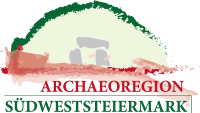At the end of 2016, the three-year project “The paleolandscape of Styria and its biodiversity from prehistory to the discovery of the New World / Paleokrajina Štajerske in njena biodiverziteta od prazgodovine do odkritja Novega sveta” (PalaeoDiversiStyria) began, co-funded by the Interreg Slovenia-Austria 2014-2020 program.
The project focused on original plant species that could be identified from archaeological find contexts with the use of archaeobotany. The now almost forgotten plant varieties, which were once the main source of food for our ancestors, were to be reintroduced into the production of domestic farms in the second part of the project, thereby promoting biodiversity on our farmlands. The revitalized plants will be used to develop high-quality products for tourism which draw their character from the local archaeological heritage. By becoming a distinctive brand of the touristic offer, these products contribute to raising awareness of the archaeological heritage of the region.
The project partnership consisted of two institutions from the field of archaeology, two institutions from the field of botany and two municipalities. The Joanneum Universal Museum and the Monuments Office of the Republic of Slovenia undertook the archaeological research in order to establish a solid scientific basis. The Institute of Plant Sciences at the Karl Franzens University in Graz and the Faculty of Agriculture and Life Sciences at the University of Maribor own botanical gardens and thus have the necessary test areas for the revitalization of some forgotten plant varieties. The tourism component of the project was tested for its practical feasibility in two pilot areas, in the market municipality of Grossklein in southern Styria and in the municipality of Hoče-Slivnica in eastern Slovenia. The project partnership promoted the cooperation of the scientists with local businesses and tourism providers.
As one of the major milestones of the PalaeoDiversiStyria project, the international umbrella brand HERITERRA was developed in 2019. HERITERRA – the name combines the English term “heritage” for (cultural) heritage with the Latin term for earth “terra” – stands not only for quality and regionality, but also for the historical diversity that has developed over millennia.
Under this brand, experts from the fields of agriculture, gastronomy and arts and crafts create new products from, among other things, the old plant varieties and with the help of recipes that have been handed down. These products are included in the line of goods of local businesses. The ingredients, materials and production techniques stick as closely as possible to the historical model. Information about the brand can be found at www.heriterra.eu.
As part of the project, archaeologists from the Joanneum Universal Museum carried out excavations in Kleinklein near Grossklein in order to obtain samples for archaeobotanical analyses. The excavation site was located in the immediate vicinity of the Iron Age princely tomb “Kröllkogel.” Wall foundations of a building dating from the Roman period and probably belonging to a large estate (villa rustica) were laid open. In addition, waste pits from the Early Middle Ages were discovered – a rare finding for Styria.
Project partners:
- Joanneum Universal Museum (Lead partner)
- Monuments Office of the Republic of Slovenia / Zavod za varstvo kulturne dediščine Slovenije
- Karl Franzens University Graz, Institute for Plant Sciences
- University of Maribor, Faculty of Agriculture and Life Sciences / Univerza v Mariboru, Fakulteta za kmetijstvo in biosistemske vede
- Market municipality Grossklein
- Občina Hoče-Slivnica
Department of Archaeology and Coin Cabinet
Eggenberger Allee 90
A-8020 Graz
T: + 43 316 8017 9560
archaeologie@museum-joanneum.at
www.museum-joanneum.at
Text: Dr. Marko Mele


